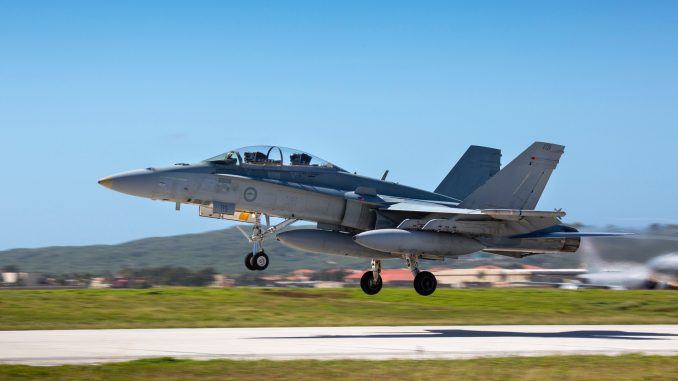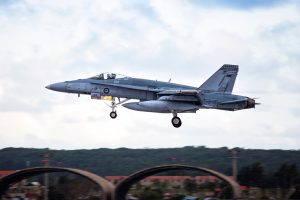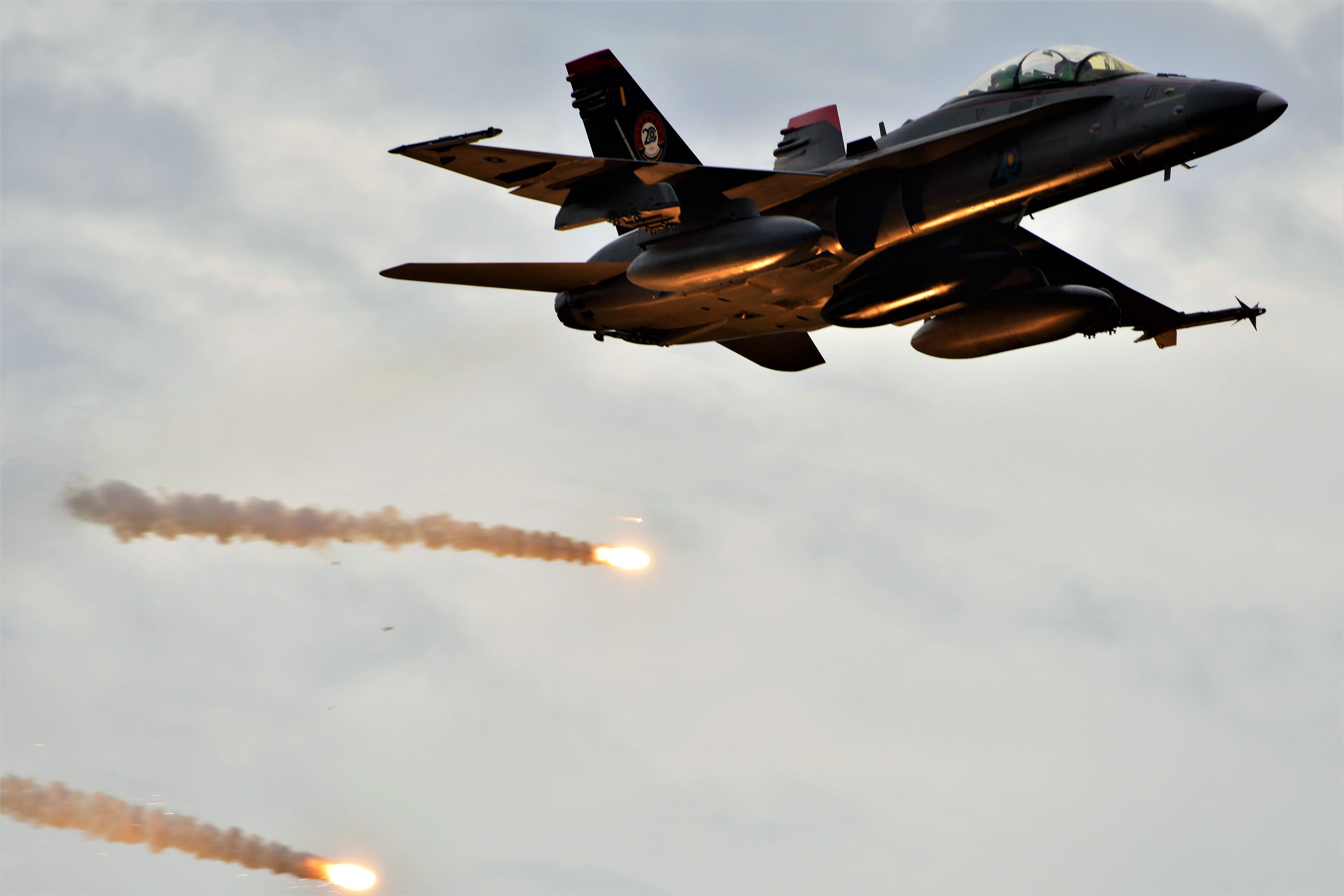
SHAH ALAM: Oz sells classic Hornets for air combat training. Australia has announced the sale of its remaining fleet of RAAF Classic Hornets, up to 46 aircraft, to a US air combat training company. Two years ago Australia announced the sale of 25 Classic Hornets to Canada.
F/A-18 disposal provides Hunter region jobs
5 March 2020Workers at RAAF Base Williamtown will service and prepare up to 46 retired F/A-18 Classic Hornet aircraft that will be sold to air combat training company Air USA.
The Classic Hornet aircraft will be used to provide training services to the United States Air Force and will be prepared over the next three to four years.
Minister for Defence Industry, the Hon Melissa Price MP, said the work will provide employment certainty for workers in the NSW Hunter region.
“The work to prepare these aircraft and components for sale will provide 24 direct industry jobs while Air Force transitions from the Classic Hornet to the F‑35 Joint Strike Fighter,” Minister Price said.
“This highlights the strong performance of the region’s defence industry in servicing and maintaining the Classic Hornets over the past 30 years.”
“Apart from the jobs directly supported by the work at RAAF Base Williamtown, more defence industry jobs are expected to be created across Australia through repair and overhaul work on aircraft servicing components.”
The RAAF Classic Hornet fleet is being progressively retired as the F-35A Joint Strike Fighter is introduced into service. The Morrison Government has now taken delivery of 20 Joint Strike Fighters, out of a total order of 72.

With the deal, all of 71 classic Hornets, some of which had been retired from the RAAF will be disposed off, likely leaving not a single aircraft to be preserved in museums or other locations. This also meant that Malaysia will only havbe Kuwaiti Hornets as a potential buy in the near future. It must be noted that RAAF Hornets were never seriously considered for RMAF needs apart as a source of spares.
— Malaysian Defence





Ah sucks!
If a commercial company interested in them, it surely is sold for very2 cheap price. Another great opportunity lost…
So please kementah, take a look at the aussie S-70A-9 before that is also taken away by civilian companies.
More info on the company that buys the aussie hornets…
This is the same company that buys all of South Korea BAe Hawk 63 Trainers.
http://live.staticflickr.com/7627/16601888368_d0cebb6b36_h.jpg
You can see the US FAA serial N509XX beneath the ROKAF serial on the fin.
Anyway, basically the aussie hornets are gone. The only option now is the kuwaiti hornets. But when would they be really available? Typoons will be delivered from 2020-2023. Super Hornets from 2021.
” Originally, the KAF was intending to sell the bulk of the single-seater F/A-18Cs and hold on to the dual-seater F/A-18Ds for aggressor training, but those plans have now been dropped. Instead, all of the aircraft will now be disposed of but, according to Garcia (Alan Garcia – Boeing), that will not happen until all of the Super Hornets have been delivered ”
So now at best, we can only expect the Kuwaiti Hornets to be available in 2024. Then about 10 years of use to around 2035 when it should be replaced by 5th Gen MRCAs.
Another thing. Should we also offer our Hawks (which are radar equipped, a thing that would be of interest), MB339CM and MiG29Ns for sale to these air combat training companies?
typo
Should be Hawk 67
NX509XX
We are years away from being able to offer our Hawks and MBb-339s to anyone; given their replacements have yet to be ordered and if ordered, will unlikely be in the numbers that will allow us to retire the Hawks and MBB-339s. At least not in the short term.
As for the APG-66s; remains to be seen if a future customer in a few years time will still intend on operating it; given its age. If I’m not mistaken parts are no longer bring supplied by the OEM but from companies approved to do so.
What we can and should do is to dispose of the Fulcrums. The longer we store them the less desirable they’ll be to potential customers. Not too mention that their value lies in their airframes : the sensors and avionics fit is dated and the engines in need of an overhaul. Sure, we’ll probably get less for them compared to what we’d like but it’s not as if potential buyers are not spoilt for choice and keeping them in storage indefinitely serves no purpose.
@ azlan
Air combat training companies still use the APG-66. Draken with its APG-66 equipped Skyhawks. As is plenty of F-16 equipped countries.
What about our MiG-29N? The same company that buys the aussie hornets also has a few MiG-29 in its fleet.
What is interesting is that these civilian air combat training companies are really pushing the envelope on putting new technologies into old airframes. For example Tacair’s F-5AT even has Thales Scorpion HMD! If it can be bought by a for profit company, surely it is affordable for us to upgrade our MKM with the same Scorpion HMD for example.
www2.l3t.com/forcex/pdfs/data_sheets/Venom.pdf
…. – “Air combat training companies still use the APG-66. Draken with its APG-66 equipped Skyhawks. As is plenty of F-16 equipped countries”
I was referring to years down road, when we actually retire the Hawks.
“As for the APG-66s; remains to be seen if a future customer in a few years time will still intend on operating”
…., – “ surely it is affordable for us to upgrade our MKM””
Probably but for me the most pressing requirement for the MKMs is a data link. I won’t go as far as using the term/cliche “game changer” but data links will fundamentally change the way we do things; namely enabling aircraft to perform a passive launch of a AAM with input from another aircraft and for aircraft to share info with one another; as well as from other assets.
…., – “What is interesting is that these civilian air combat training companies are really pushing the envelope on putting new technologies into old airframes””
To be expected. They have to make their platforms and level of training as advanced/realistic as possible to ensure training provided keeps with the times and can simulate what a pilot will encounter when transitioning to a MRCA when in actual combat.
Similarly; high end LIFTs have very advanced cockpits and features to enable the aircraft to replicate as close as possible current gen MRCAs and to enable pilots to make a smooth transition; i.e. if a pilot is going to end up flying a MRCA with a holographic HUD that can also display imagery; it makes sense for a LIFT to be similarly equipped. If a pilot is expected to go into combat against opponents who have a HMS and a IR AAM; enabling off boresight shots to be taken; makes sense for a platform performing simulated services to be similarly equipped.
In an ideal world air arms would have LIFTs that have a similar cockpit fit out to their MRCAs; of course not many can afford to do so.
…., – “If it can be bought by a for profit company””
Because the said company has ongoing long term contracts that provide it with healthy revenue and profitability over a set period. Whatever it spends as an investment more than pays for itself eventually.
@ azlan
“If it can be bought by a for profit company”
What I meant is, if the modification cost is very high, a for profit company would not have done it as it will cut into its profit. Seeing them doing the upgrades means that the cost is affordable and not going to impact on its planned profits.
Well, we have work out for our new MinDef Minister whoever that is. He/she will need to check if our govt’s serious about procuring the Kuwaiti Hornets and it must be on ASAP basis!
…..
One for you.
When an aircraft is employing an active jammer (emits signals to confuse the seekers of incoming radar guided AAMs); does this have any effect on the aircraft’s radar?
@…
These private aggressor contractors are akin to Blackwater & co, they earn their profits from government subsidised contracts(their version of tongkat) and from cutting out bureaucratic redtape inefficiencies. Whatmore this is a very limited supply scenario so they pretty much can command whatever price they want within reasonable margins. Hence as long the US military haven’t change their outsource policy, they won’t likely go out of business as its pretty much a profit guaranteed deal. You can bet they will bring out all their connection & monetary arsenal if they even smell this coming.
OTOH this is a competitive field as they have technical & performance criteria to meet so they constantly need to reinvest to update their fleet but again this gets plenty of Government support & subsidies.
As part of US defence industry behemoth, the Government cannot and will not allow these businesses to fail but at same time, they aren’t reliant on a single source so the prosperity is shared around.
This unlike our Armed Forces, we cannot make money out of investing on new hardware which is why the Government have been hesitating to spend unless its for big projects that can create jobs.
@ azlan
Current radar jammers (unlike comm jammers), like our SAP-518 are able to jam specific bandwidths and puts out jamming bursts in response to radar signals of the jammed system by the use of DRFM (digital radio frequency memory). The output looks natural that the receiver won’t even realise the fake radar returns are not real. So its own radar wont be affected.
Why in peacetime, getting radar signals for EW library is important (to understand its frequency hopping style etc). SAP-518 can return false locations, and also return multiple targets so that the sensor sees more targets than there is. Jamming effects on AAM is something people rarely say when boasting about BVR kills.
Latest AESA radar should be less affected by jamming as each of its thousands of transmit/receive modules can burst out different frequencies at the same time! Analog radars usually has only 1 transmit module, so advanced computer processors on latest DRFM jammers can easily calculate its frequency hopping. Still jammers are very effective to counter radar equipped AA missiles as their radar is not as advanced as fighter AESA radar.
….. – ”Still jammers are very effective to counter radar equipped AA missiles as their radar is not as advanced as fighter AESA radar.”
Yes. The primary use of active jammers on aircraft are to jam or confuse the seekers of radar guided AAMs.
Back on the advanced upgrades of old fighters by US civilian companies
this is the picture of F-5AT equipped with Thales Scorpion Helmet Mounted Display (HMD)
http://pbs.twimg.com/media/ETTRRFhUMAE47d8.jpg